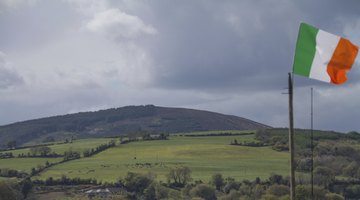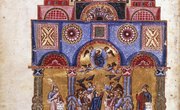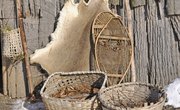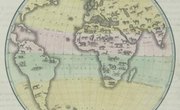Only the narrow Irish Sea separates Scotland from Ireland geographically, but centuries of history separate them culturally. Both are Celtic nations with long histories of strife with England, and both have deeply influenced the U.S. Nonetheless, they are separate nations with distinct, if related, histories and cultures. Leprechauns, St. Patrick and the shamrock are associated with Ireland, while Scotland may bring to mind kilts, tartans and the Loch Ness Monster. The real differences go much deeper.
Different Governments
At one time, both Ireland and Scotland were part of the British Empire, but most of Ireland gained independence in 1921. Six Northern counties remain part of the United Kingdom, the constituent state of Northern Ireland; the bulk of the island and population, however, make up the independent Republic of Ireland. Scotland, on the other hand, is entirely part of the United Kingdom. English incursion began in the Middle Ages, and the two countries formally joined in 1707. Scotland may join Ireland in independence, depending on the outcome of a national referendum on separating from the United Kingdom.
Different Languages
In addition to English, both nations have native Gaelic languages. Scotland’s 2011 census found that 1.1 percent of the population spoke Scots Gaelic. In the Republic of Ireland, by contrast, 41.4 percent spoke Irish Gaelic. The differences between Irish and Scots Gaelic are not just demographic. The two languages began to diverge around A.D. 400, when Irish settlers migrated from what is now Northern Ireland’s County Angrim to what is now Scotland’s County Argyll, according to an account by archeologist Dean R. Snow. Caoimhin P. Ó Donnaile, of Scotland’s University of Highlands and Islands, prepared an introductory vocabulary that shows the relationships and differences between the two Gaelics. One distinction stems from Ireland’s revision of official Gaelic spelling in the late 20th century, which removed extraneous consonants.
Different Religions
Religion sharply divides the two nations as well. Ireland is predominately Roman Catholic, accounting for 84.7 percent of the population as of 2011. Northern Ireland is mostly Protestant, which accounted in large part for those counties’ separation from the newly independent Republic. In Scotland, on the other hand, only 54 percent of the population identify as Christian of any denomination. Nearly a third belong to the Church of Scotland, a Reformed, or Protestant, faith community; only 14 percent are Roman Catholic.
Different Customs
While you may find traditional Celtic images like the circled cross and sounds such as the lilting music of pipe and fiddle in both Ireland and Scotland, they have distinct cultures and customs. Scotland is the home of the bagpipe, a droning and famously loud instrument that produces both harmonies and melody; Ireland has a traditional bagpipe, but it is smaller and less well-known than its Scots cousin. The signature musical instrument in Ireland is the harp, which is featured on the Republic of Ireland’s flag. Scotland is also known for its national dish, haggis, a type of sausage made from sheep’s stomach filled with oats and ground meat. Ireland is better known for its beers, especially Guinness stout, which is exported around the world, as well as hearty stews and bread. Interestingly, both nations produce signature whiskeys, a word which derives from Gaelic; in Scotland, however, it is spelled “whisky.”
Related Articles
References
- Scotland, the Official Gateway to Scotland: Scottish History
- The Scottish Government, Riaghaltas na h-Alba: Scotland’s Referendum
- Scotland’s Census 2011: Release 2A, Key Results on Population, Ethnicity, Identity, Language, Religion, Health, Housing and Accommodation in Scotland
- Republic of Ireland, Central Statistics Office: Census 2011 This is Ireland, CDD31, Popullation Age Three Years and Over and Percentage of Irish Speakers by Age Group, Sex, CensusYear and Statistic
- Archeological Institute of America, Archeology Magazine: Scotland’s Irish Origins; Dean R. Snow
- Comparison of Scottish and Irish Gaelic; Caoimhin P. Ó Donnaile
- Master of Malt: Whisky or Whiskey
Writer Bio
Jennifer Spirko has been writing professionally for more than 20 years, starting at "The Knoxville Journal." She has written for "MetroPulse," "Maryville-Alcoa Daily Times" and "Some" monthly. She has taught writing at North Carolina State University and the University of Tennessee. Spirko holds a Master of Arts from the Shakespeare Institute, Stratford-on-Avon, England.











